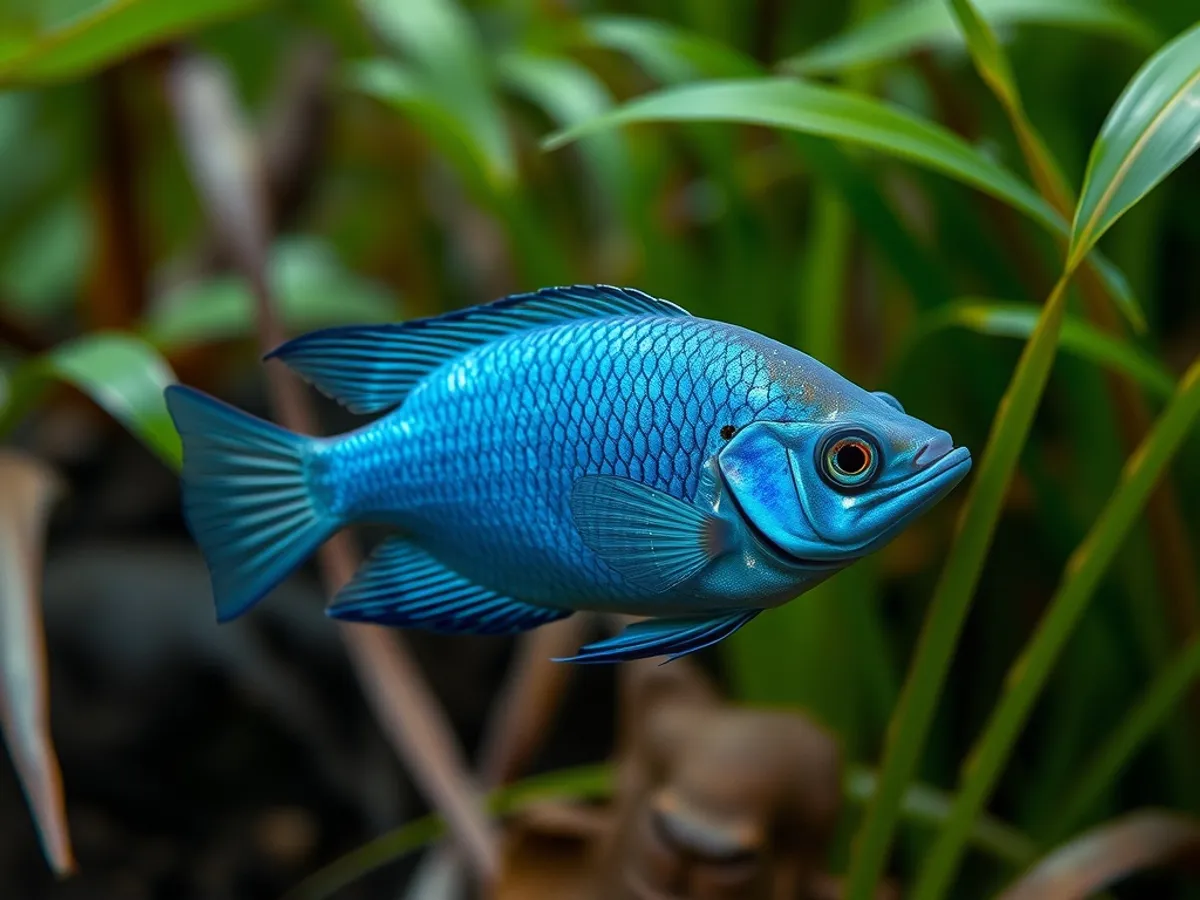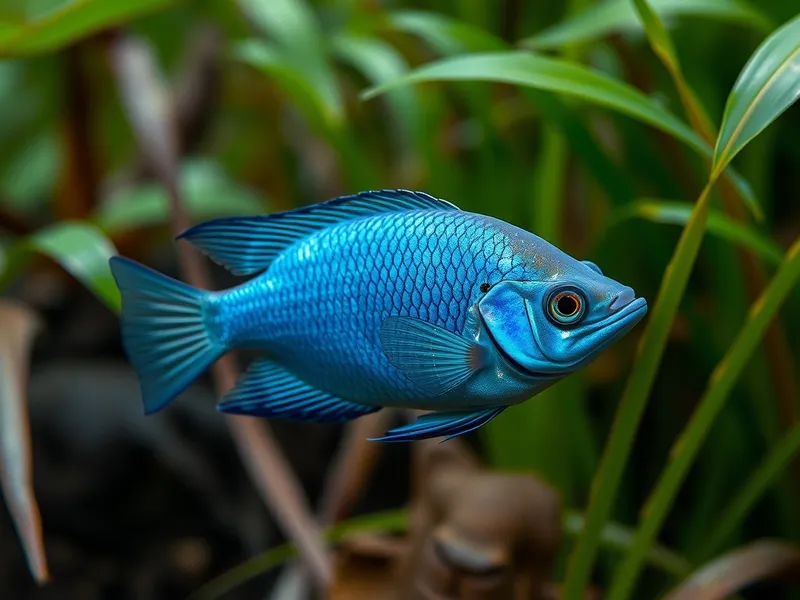
Blue Gourami
Trichopodus trichopterus

Meet the Blue Gourami
The Blue Gourami, also known as the Three-spot Gourami, is a popular freshwater fish native to Southeast Asia. It is recognized for its shimmering blue or pale blue coloration and the two distinctive spots on each side of its body, with the third 'spot' being its eye. Blue Gouramis are labyrinth fish, meaning they can breathe atmospheric air using a specialized labyrinth organ. They are hardy and adaptable, making them a common choice for home aquariums. In the wild, they thrive in slow-moving waters with dense vegetation.
Classification
Fish
Habitat
Slow-moving freshwater rivers, swamps, and lakes with abundant vegetation
Diet
Omnivore
Lifespan
4-6 years
Conservation
Least Concern
Weight
30-80 grams
📖Fascinating Facts
Bubble Nest Builder
Male Blue Gouramis create intricate bubble nests at the water’s surface using air bubbles and saliva to protect their eggs and fry.
Labyrinth Organ
They possess a labyrinth organ that allows them to breathe atmospheric air, enabling survival in low-oxygen environments.
Color Changes
Blue Gouramis can subtly change their coloration based on mood, health, and breeding status, with males becoming more colorful during courtship.
📋Detailed Description
The Blue Gourami (Trichopodus trichopterus) is a medium-sized freshwater fish, typically reaching up to 15 cm in standard length, though some individuals may grow slightly larger in optimal conditions. Its laterally compressed body is adorned with a shimmering blue or pale blue hue, often interspersed with iridescent spots and marbling, depending on the morph. The species is named for the two prominent dark spots along each side of its body, with the eye serving as a third 'spot.' Its long, filamentous pelvic fins are highly sensitive and are used for tactile exploration of the environment. The dorsal and anal fins are elongated, especially in mature males, and can be used for display during social and reproductive interactions. Blue Gouramis possess a labyrinth organ, a specialized respiratory structure that allows them to breathe atmospheric air, enabling survival in oxygen-poor waters. They are known for their adaptability, thriving in a range of water conditions and habitats, from slow-moving rivers and swamps to rice paddies and floodplains. Socially, they can be both peaceful and territorial, with dominance hierarchies often forming in groups. In the wild, they are omnivorous, feeding on a variety of invertebrates, plant matter, and detritus. Their reproductive strategy involves bubble nest building, with males exhibiting elaborate courtship and parental care behaviors. Blue Gouramis are widely distributed across Southeast Asia, with introduced populations established in other regions due to their popularity in the aquarium trade.
💡 Did you know?
Blue Gouramis can breathe air directly from the surface, allowing them to survive in oxygen-poor waters where many other fish cannot.
🔬Research & Sources
Wikipedia Summary
The three spot gourami, also known as the opaline gourami, blue gourami, and gold gourami, is a species of fish native to southeastern Asia, but also introduced elsewhere. This gourami gets its name from the two spots along each side of its body in line with the eye, considered the third spot. This species is of minor commercial importance as a food fish in its native range and is also farmed. It is also popular in the aquarium trade. The species reaches 15 cm in standard length.
Last Modified: 4/18/2025
🎭Behavior & Social Structure
Blue Gouramis are generally diurnal, being most active during daylight hours. They are omnivorous foragers, feeding on aquatic insects, zooplankton, crustaceans, algae, and detritus. In the wild, they often browse among submerged vegetation, using their tactile pelvic fins to sense food and navigate their surroundings. In captivity, they readily accept a wide range of foods, including flakes, pellets, and live or frozen invertebrates. Socially, Blue Gouramis display a complex mix of behaviors: while juveniles and females are typically peaceful, adult males can become territorial, especially during breeding periods. Males may display lateral displays, fin flaring, and chasing to establish dominance or defend nesting sites. In groups, a clear social hierarchy often emerges, with dominant individuals controlling access to preferred territories. They are known to interact with conspecifics and other fish species, sometimes exhibiting mild aggression if overcrowded or if tank conditions are suboptimal. Resting periods are common at night, with fish seeking shelter among plants or submerged structures.
👶Reproduction & Life Cycle
Blue Gouramis are oviparous and exhibit elaborate reproductive behaviors. Breeding typically occurs during the rainy season in the wild, when water levels and temperatures rise. Males construct bubble nests at the water's surface using air bubbles coated with saliva, often anchoring the nest among floating vegetation. Courtship involves the male displaying vivid coloration and performing a series of circling and fin-flaring movements to attract a female. Once receptive, the female releases eggs during a spawning embrace, which the male fertilizes externally. The eggs, numbering from several hundred to over a thousand per spawning event, are buoyant and float into the bubble nest. The male guards the nest aggressively, tending to the eggs and repairing the nest as needed. Incubation lasts 24–36 hours at optimal temperatures (26–28°C), after which the fry hatch and remain in the nest for several days until they become free-swimming. Parental care is provided solely by the male; after hatching, he continues to protect the fry until they disperse.
🛡️Adaptations & Survival
The most distinctive adaptation of the Blue Gourami is its labyrinth organ, an accessory respiratory structure that allows it to extract oxygen directly from the air. This adaptation is crucial for survival in hypoxic (low-oxygen) environments such as stagnant swamps and rice paddies. Their elongated pelvic fins are highly sensitive and function as tactile organs, aiding in navigation, foraging, and social interactions in turbid or densely vegetated waters. The species' variable coloration provides camouflage among aquatic plants, reducing predation risk. Behavioral plasticity, including the ability to tolerate a wide range of water parameters (pH 6.0–8.8, hardness 5–35 dGH), allows Blue Gouramis to colonize diverse freshwater habitats. The bubble nest reproductive strategy is another key adaptation, ensuring offspring survival in environments where dissolved oxygen is low and predation pressure is high.
🎨Cultural Significance
Blue Gouramis hold considerable importance in the aquarium trade, prized for their hardiness, adaptability, and attractive appearance. They are among the most popular labyrinth fish kept by hobbyists worldwide. In parts of Southeast Asia, they are also farmed as a minor food fish, though not as extensively as other gourami species. There are no prominent mythological or symbolic associations, but their presence in traditional village ponds and rice fields has made them a familiar species in rural life. Selective breeding has produced several ornamental varieties, including the opaline, gold, and platinum morphs, further enhancing their cultural and economic value.
🔬Recent Research & Discoveries
Recent research on Trichopodus trichopterus has focused on its adaptability to changing environmental conditions, particularly its tolerance to hypoxia and variable water chemistry. Studies have examined the genetic diversity among wild and captive populations, revealing significant phenotypic plasticity and potential for further selective breeding. Investigations into labyrinth organ development have provided insights into the evolutionary biology of anabantoid fishes. Behavioral studies have explored the role of tactile communication via pelvic fins and the impact of social structure on stress and aggression in captive environments. Ongoing research also addresses the ecological impact of introduced populations and their interactions with native species in non-native habitats.
🎥Wildlife Videos

Alpine Rivers: The Cradle of Life | Free Documentary Nature
Alpine Rivers: The Cradle if Life | Nature Documentary Watch 'Alpine Lakes - An Enchanting Underwater World' here: ...
Free Documentary - Nature

Blue Whisper - The Fascinating World Beneath the Waves | Free Documentary Nature
Blue Whisper - The Fascinating World Beneath the Waves | Ocean Documentary Watch 'Adventure Ocean Quest: Discovering ...
Free Documentary - Nature

The Big Blue - Ocean Stories from Down Under | Episode 6 | Free Documentary Nature
The Big Blue - Ocean Stories from Down Under | Episode 6: Stewart Island | Ocean Documentary Watch 'The Big Blue - Episode ...
Free Documentary - Nature

Species Spotlight | Blue Gourami
Aquatics expert Tom Sarac provides an in-depth overview of the blue gourami! Available in multiple varieties (gold, opaline, ...
Fluval Aquatics

Giant Gourami: The Largest Species of Gourami
Giant Gourami: The Largest Species of Gourami.
World Fish Lover Expo

Blue Whisper - Go Wild
"Blue Whisper" immerges into the ocean's fascinating underwater world and gets to the bottom of a widely unexplored field of ...
Go Wild
🌍Habitat Information
The Blue Gourami typically inhabits Slow-moving freshwater rivers, swamps, and lakes with abundant vegetation environments. Blue Gouramis have adapted to their environments with specialized features and behaviors.
Primary Habitat:
Slow-moving freshwater rivers, swamps, and lakes with abundant vegetation
More detailed habitat information will be available soon.
🛡️Conservation Status
The Blue Gourami is currently classified as Least Concern. Conservation efforts are crucial for preserving this species for future generations.
Common Threats:
- 🏠Habitat loss and fragmentation
- 🌡️Climate change impacts
- 🎯Hunting and poaching
- 🏭Human-wildlife conflict
⚠️Threats & Conservation Challenges
Currently, Blue Gouramis are classified as Least Concern by the IUCN, with stable populations across their native and introduced ranges. However, localized threats include habitat degradation due to wetland drainage, pollution, and agricultural expansion. Overharvesting for the aquarium trade is not considered a significant threat due to successful captive breeding programs. Invasive populations in non-native regions may impact local ecosystems by competing with indigenous species. Climate change and water management practices could alter their habitats, potentially affecting breeding and survival. Disease outbreaks, particularly in aquaculture settings, can also pose challenges, with pathogens such as Aeromonas and parasites occasionally causing mortality.
🔬Scientific Classification
Scientific Name
Trichopodus trichopterus
Classification Hierarchy
🔍 About Taxonomic Classification
Taxonomic classification is a hierarchical system used by scientists to classify and organize living organisms based on shared characteristics and evolutionary relationships.
The system moves from broad categories (Kingdom) to increasingly specific ones, with each animal's scientific name typically consisting of its Genus and species.
📝Community Notes
Share your observations and insights about the Blue Gourami with our community of wildlife enthusiasts.
Join Our Community
Sign in to share your observations and connect with fellow wildlife enthusiasts.
Sign In to ContributeNo community notes yet
Be the first to share your observations about the Blue Gourami!
Explore Blue Gourami
Select a tab above to learn more about this amazing animal.
📸Photo Gallery
No photos available for this animal yet.
🌟Discover More Wildlife
Continue your journey of discovery with more fascinating animals from our database
